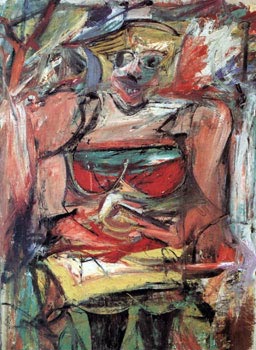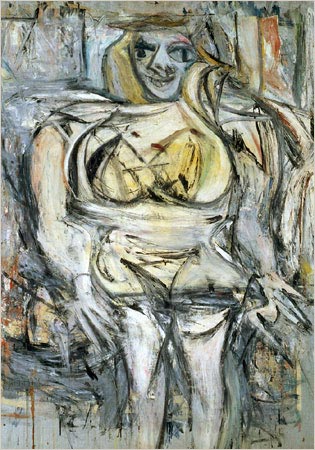| Willem De Kooning | |
|---|---|
 |
|
| Born | April 24, 1904 Rotterdam, Netherlands |
| Died | March 19, 1997 (at age 92) Long Island, New York United States |
| Nationality | Dutch, American |
| Education | Rotterdam Academy of Fine Arts Royal Academy of Fine Arts in Brussels, Belgium |
| Movement | Abstract expressionism |
| Field | Painting, Sculpting |
| Works | View Complete Works |
Willem de Kooning (1904-1997) was a Dutch-born American painter of the expressionist style. The main niche of his work was dynamic brush and warped forms and a continuous exploration between human form depiction and abstraction. He was a prominent member of the abstract expressionism movement that aimed at depicting the unconstrained and dynamic art of painting.
Early Life and Training
De Kooning was born in Rotterdam, in the Netherlands in 1904. His biological parents were Leendert de Kooning and Cornelia Nobel. They divorced when he was only five and as a result, he was raised by his mother and stepfather. From 1916, he joined the Rotterdam Academy of Fine Arts and the Royal Academy of Fine Arts in Brussels, Belgium, where he received expert training in the realm of drawing and painting for 8 years. In 1926, he relocated to the United States of America and established himself in New York City in 1927.
Works and Influences
 His earliest known work is called the Two Men Standing, which was completed in 1938 and is found in the Metropolitan Museum of Art in New York City. In this painting, De Kooning depicts dark figures of men standing in an unclear setting. The figures, some of which are thought to be self-portraits take inactive stances and show no relationship to each other or to any connecting activity. Selective parts of the painting show a keenly regulated technique while the other parts give a feel of incompleteness. This lack of consistency became a prominent characteristic of Kooning’s pieces.
His earliest known work is called the Two Men Standing, which was completed in 1938 and is found in the Metropolitan Museum of Art in New York City. In this painting, De Kooning depicts dark figures of men standing in an unclear setting. The figures, some of which are thought to be self-portraits take inactive stances and show no relationship to each other or to any connecting activity. Selective parts of the painting show a keenly regulated technique while the other parts give a feel of incompleteness. This lack of consistency became a prominent characteristic of Kooning’s pieces.
Another major piece Willem de Kooning is known for is the Attic, which was completed in 1949 and is still displayed in the Metropolitan Museum of Art. In this master-piece, Willem introduced the cubist characteristic of fragmented forms that form series of overlapping geometric planes. Like most of works, there are evident allusions to unfinished human forms on the canvas. Scattered parts of the human form can be traced on the work, for instance and eye or teeth. Fragmenting organic forms as opposed to geometric forms, accentuates a feeling of violence that is evident in most of his works.
From the early 1950s, he used slashing painting strokes of color to come up with compositions of women. In the majority of these pieces, a domineering structure of angular shapes hides a brutally deformed figure with embellished female features such as hips, breasts and lips. His divergence from abstraction dissatisfied some of ardent fans, because many modern art critics felt that art should progress linearly, moving from realism to abstraction and not the reverse. His depiction of women also caused uproar among feminists who perceived his dynamic strokes promoting violence towards the female body. In his defense, Kooning was influenced by prehistoric fertility figure including those of the Venus figurine from the region of Willendorf, Austria (30,000-25,000 BC) or figures prevalent in the pop culture such as that of Marilyn Monroe.
 Kooning’s work falls in unclear boundaries between abstraction and figuration. His painting Easter Monday, completed in 1956, utilizes abstract brush strokes with discernible photographs of human forms and lettering. These photographs and letters ended up on the canvas because he used newspapers to cover his paintings in an effort to prevent them from drying too fast while working. This occurred accidentally at first, but he later used this effect intentionally after learning to anticipate and control the results. Application of this effect in his freely painted work influenced many generations of abstract expressionists, including Robert Rauschenberg and many others.
Kooning’s work falls in unclear boundaries between abstraction and figuration. His painting Easter Monday, completed in 1956, utilizes abstract brush strokes with discernible photographs of human forms and lettering. These photographs and letters ended up on the canvas because he used newspapers to cover his paintings in an effort to prevent them from drying too fast while working. This occurred accidentally at first, but he later used this effect intentionally after learning to anticipate and control the results. Application of this effect in his freely painted work influenced many generations of abstract expressionists, including Robert Rauschenberg and many others.
Yet again, his compositions transformed in the 1960s, opening up with elongated, wider bands of color that gave rise to landscape forms. A decade later, his works became overpopulated with brush strokes. He produced subtle and more poetic pieces in the 1980s, which were characterized by rings and warped lines of red, blue, orange or white surfaces.
He also experimented with abstract expressionist sculpture in the 1950s. An example of a sculpture done by Kooning is the Woman V (1952-1953). It depicts his characteristic violence in distorting human figures found in most of his works. This piece is exhibited in the National Gallery of Australia.
Awards and Recognition
The majority of works done by Willem de Kooning are showcased in the Modern Museum of Art in New York City. He has received various awards, including the Presidential Medal of Freedom, which was presented to him by President Johnson in 1964. He was also awarded the National Medal of Arts in 1986. Along with Eduardo Chillida, he received the Andrew w. Mellon price in 1979 followed by a showcase of his works at the Carnegie Institute, Pittsburgh.